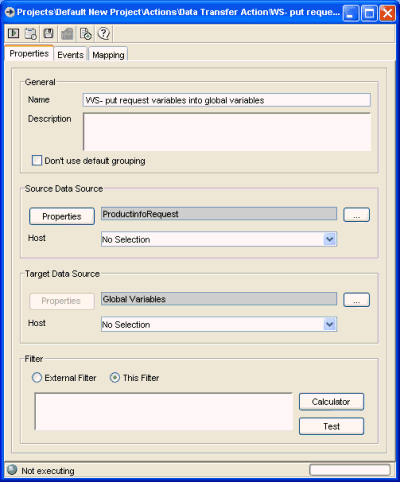
The Properties tab is discussed below, use these links for the Events tab and Mapping tab.
Data transfers actions (DTAs) involve mapping data from one structure to another and are therefore fundamental to integration tasks. Properties of data transfer actions include the names and properties of both the source data source and the target data source of the transfer, as well as the Mappings that define the relation between these data sources, see Data transfers overview and Data source overview for more. Here is an illustration of a DTA properties window with properties already entered (see 4.create DTA for request from How to provide a web service for more details on this example):

See Action properties for details on how to get to this window, details on the icons at the top of the screen, on the Name and description fields, status bar and Events tab, all of which apply to all actions.
A large amount of information is needed to define a data transfer. You can view, enter or alter properties of the data transfer, and also access properties of the source data source, target data source, the filter if any that is used to select data from the source during the transfer. In addition you can view, enter or alter the mappings between entities and fields in the source to the entities and fields in the target data source which is at the heart of the data transfer. Other headings include
Don't use default grouping: During the data transfer action the system attempts to automatically group its target data based on unique key information you have provided. Default grouping uses the contents of all fields in the entity to provide the grouping when the user has neglected to set a grouping calculation for a field mapping in a data transfer action. This checkbox allows this default grouping to be turned off, in which case you will need to perform manual grouping in the Mapping screen during definition, i.e. by dragging source fields onto the target entities. See Mapping and Grouping Calculations.
Source and Target data source information can be viewed or altered from the data transfer action properties screen. For each data source you will be able to set or view:
Data source name: is displayed to the right of the Properties button for an existing data source, or if you are creating a new data transfer action you can browse to select the source or target data source for this transfer from a window showing all available data sources on screen, see New data transfer for more.
Properties: Press this button to see the properties of the source or target data source for an existing data transfer action, see Data source types for links to the various data source properties windows.
Host: Allows selection of a remote host for the source or target data source.
Filtering of data is determined at the bottom of the screen, i.e. your entries here determine which data in the source is to be mapped to the target data source. You have the options:
External filter: The default filtering option is to leave this checked if you want any filtering to be determined externally to the action itself. Leaving this checked means that when the data transfer action is placed in an activity, the filter information that has been applied to the whole activity will be applied to this action. That is, filtering of data is determined externally, not by the data transfer action properties which is the alternative option, see below.
This filter: When this is checked, filtering is determined by information supplied with this data transfer action, i.e. by filtering details that you will now supply. When this option rather than "External filter" is chosen the buttons to the side of the text box become active. The text box is where you enter a Regular expression to be used by the filter, see Regular Expressions for more.
The Mapping tab card is where you determine the relations between the source and target entities and fields in the data transfer, see Mapping for more, or Example JDBC mapping for an illustrated discussion of a DTA, including mapping.
Related topics include Data transfers overview, Action properties, Action events, New data transfer, Mappings, Example JDBC mapping, How to provide a web service